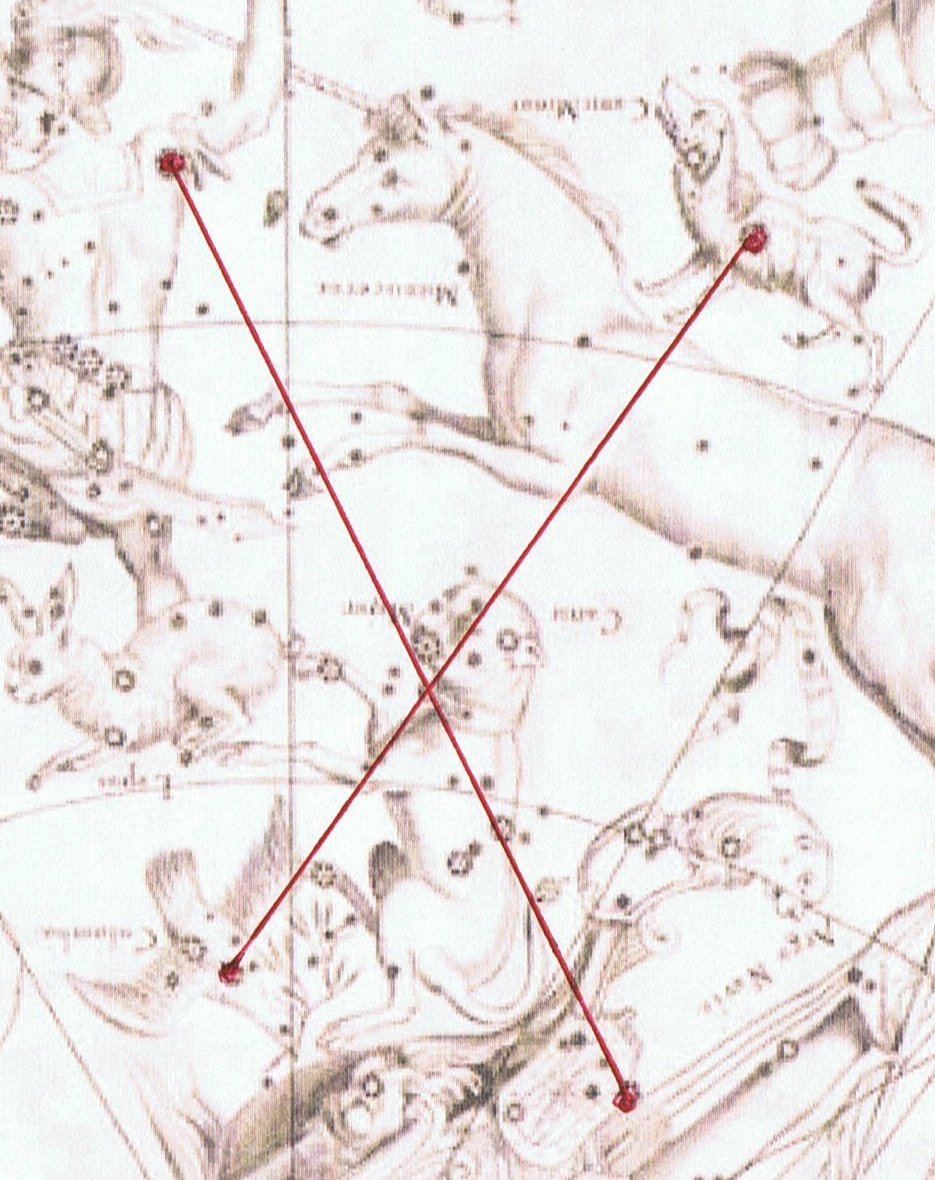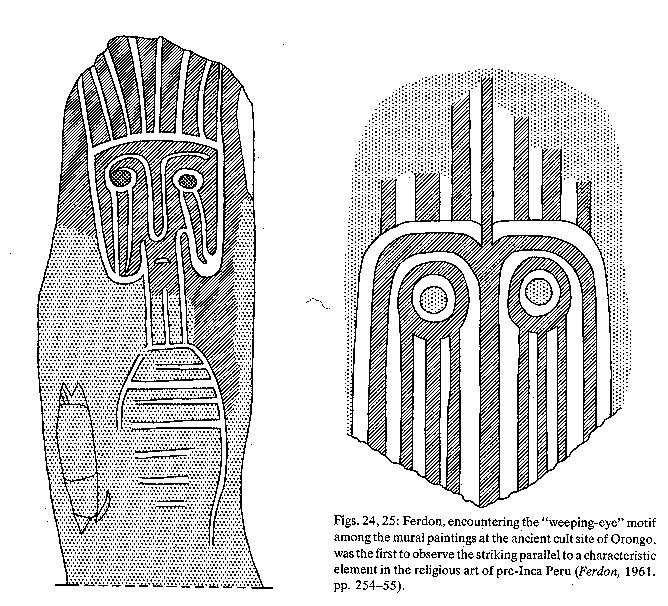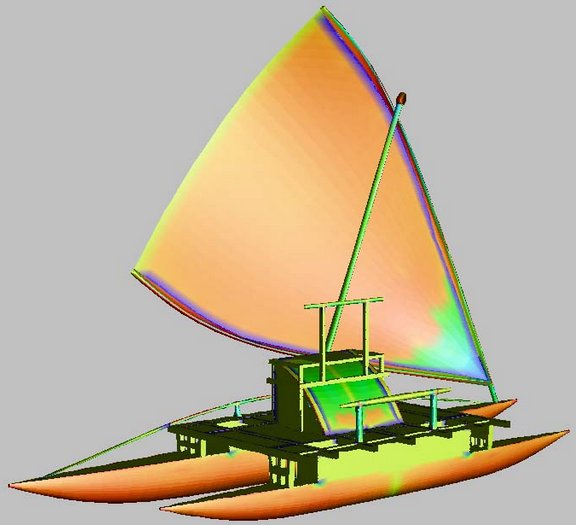Once again. In 2720 B.C. the Sun would have risen approximately at Hyadum II in MARCH 21 (0h):
The Egyptian X (like the hura type of glyph) could have illustrated a path down from Betelgeuze to Naos (ζ in Argo Navis) simultaneously with a path up from the heart of Columba to the heart of Canis Minor:
185 (JULY 4) - 80 (MARCH 21) = 105 days after 0h the Sun would have reached Zosma and Coxa. Here he could no longer be able to continue rising higher and higher but was instead forced to begin his journey down towards the southern hemisphere - he was going to the fishes. In myth this could have been illustrated with tears or rain because it was a sad time and the air could no longer keep so much humitidy when the temperatures began to drop. ... Then at last the old woman decided that Maui must be playing some trick on her. She drew out the one nail that remained, the nail of her big toe, and fire flowed from it. But instead of handing it to Maui, she dashed it to the ground, and the whole place caught fire. 'There, you have it all now!' she cried. And Maui was already running for his life, with the fire at his heels pursuing him. Looking round, he saw that the whole land would soon be aflame. So he changed himself into a karearea, a hawk, and tried to soar above the flames. But the fire pursued him there and scorched his feathers, which accounts for the colour of that bird. Seeing a lake, he plunged down into it, but found that it was almost boiling. All the forests then caught fire, the land everywhere was alight, and Maui came very near to death. Then he called on his ancestor Tawhiri matea and all his offspring, to send down rain. 'Let water be given to quench this fire!' he cried, and spoke the appropriate chants. Great clouds appeared, and Tawhiri sent down first the small rain, and then the lasting rain, and everything was drenched, and the flames went out. Even Mahuika herself almost perished before she could reach her place of shelter, and her shrieks were as loud as those of Maui when he was scorched. The waters rose all around her, and in this way Mahuika was deprived of her former power ...
At the time of Gregory XIII the stars would have been pushed ahead in the year with 64 - 4 = 60 days due to the precession. Zosma and Coxa would therefore have risen heliacally in °September 2 (245), i.e. 60 days later. At the southern spring equinox the Sun was observed to cross the equator on his way down from the northern hemisphere to Polynesia. 60 precessional days before Gregory XIII - in 2720 B.C. - they would in SEPTEMBER 22 and 185 days after MARCH 21 have seen An tares close to the Full Moon. At the time of Bharani the corresponding night would have been in "October 15 (288), because precession would at that time have moved the stars ahead in the year with 64 - 41 = 23 days since the time of the Rainy Hyades. 265 + 23 = 288. If the creator of Manuscript E had thought along these lines he could have stated that the Sun king Hotu Matua anciently (around 41 * 71 = ca 2900 years earlier) had reached Easter Island by boat.
... Utnapishtim is spry enough to tell [Gilgamesh] in great detail the story of the Deluge. He tells how Enki-Ea has warned him of Enlil's decision to wipe out mankind, and instructed him to build the Ark, without telling others of the impending danger. 'Thus shalt thou say to them: (I will ... go) down to the apsu and dwell with Ea, my (lor)d.' He describes with great care the building and caulking of the ship, six decks, one iku (acre) the floor space, as much for each side, so that it was a perfect cube [a sign of Saturn], exactly as Ea had ordered him to do. This measure '1-iku' is the name of the Pegasus-square, and the name of the temple of Marduk [the spring sun god] in Babylon, as is known from the New Year's Ritual at Babylon, where it is said: 'Iku-star, Esagil, image of heaven and earth.'
Although the creator of the G tablet probably had the heliacal stars at the time of the Bull in mind when designing the text at the beginning of side a, he should also have thought of the nakshatra stars (hōkū) at the nights of the Full Moon (Hoku).
The name Hotu (Hoku on Hawaii) for the Sun king star should be easy to understand. When in Tagaroa Uri 15 it was a Hotu night - with Antares at the Full Moon - it was a sign for recalling how anciently this time of the year had been at spring equinox (SEPTEMBER 20, 265). From this equinox there were 99 nights remaining of the cycle of the year. When the Sun and Sirius rose together in JUNE 30 also Alkes was there, with DECEMBER 30 (364) at the Full Moon:
But the Explorers had left the island to return to Hiva already 10 days after the arrival of Hotu Matua, viz. in Tagaroa Uri 25:
They stayed on Easter Island for 298 (Tagaroa Uri 25) - Maro 1 (152) = 146 (= 2 * 73) days. And in Vaitu Nui 25 (115) they had to be north of the equator in Hiva in order to once again set sail for Easter Island, which they would reach in ºJune 1 when the Sun rose at Cursa. Vaitu Nui 25 (115) - (64 - 41) = 92 (APRIL 2) and 92 (APRIL 2) + 60 = 152 (ºJune 1).
|
|||||||||||||||||||||||||||||||||||||||||||||||||||||||||||||||||||||||||||||||||||||||||||||||||||||||||||||||||||||||||||||||||||||||||||||||||||||||||||||||||||||||||||||||||||||||||||||||||||||||||||||||||||||||||||||||||||||||||||||||||||||||||||||||||||||||||||||||||||||||||||||||||||||||||||||||||||||||||||||||||||||||||||||||||||||||||||||||||||||||||||||














